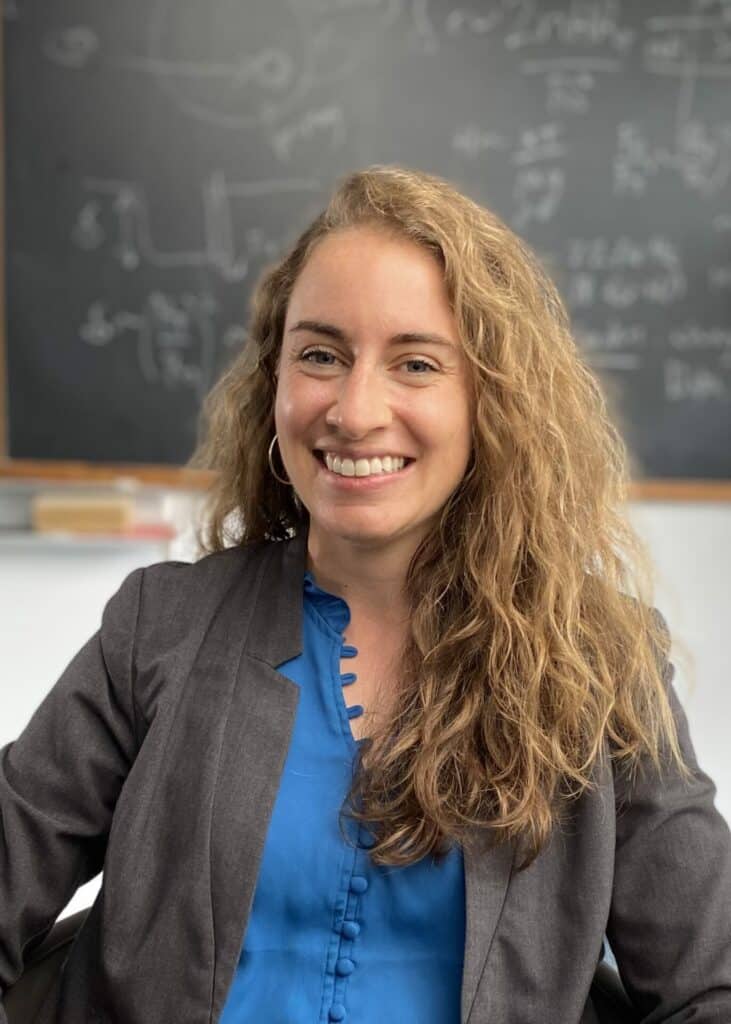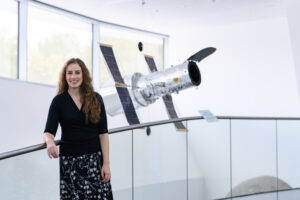At 30, Laura Kreidberg Started A New Research Department

In 2020—four years after finishing her PhD—astronomer Laura Kreidberg founded a new department at the Max Planck Institute for Astronomy in Heidelberg, Germany. In addition to her research, she would hire and direct a cohort of scientists to study the atmospheres of planets outside the solar system. She was 30 years old.
Over three years, Kreidberg has built her department up to 13 researchers, and she plans to double it in size. At her age, in most other scientific fields, she would be the green new hire, not the one calling the shots. “The Max Planck Society is open-minded about investing in young people,” she says. “They looked at me and were like, ‘This is kind of risky, but it’s a risk that we want to take.’”
That’s because Kreidberg brings a wealth of experience, despite her age. Astronomers discovered the first exoplanets in the 1990’s, and they have only begun routinely studying exoplanets in the last decade, when Kreidberg began her PhD. “I’m not that old, but I’m kind of old for the field,” she says.

Of late, her research uses NASA’s JWST, a space telescope launched in 2021, to study what types of planetary atmospheres exist, and whether those atmospheres can point to how the planet formed and evolved. (Editor’s note: Some astronomers refer to the telescope exclusively as its acronym JWST. See, e.g., this article.) Unlike its predecessors, JWST can find carbon-bearing molecules in exoplanet atmospheres. “Before, we were looking through a peephole, and now we can see more of the tapestry,” says Kreidberg. The long-term goal is to look for signatures of life.
She spoke with 1400 Degrees about the future of exoplanet research and what it’s like to wrangle researchers to tackle some of science’s most ambitious questions.
What’s the most exciting result you’ve found so far in your career?
In 2019, my collaborators and I confirmed that an exoplanet, named LHS 3844 b, did not have an atmosphere. It was the first rocky planet outside of the solar system where that type of measurement was possible. I used the Spitzer Space Telescope to look at the planet for 100 hours in a row as it went around its star nine times.
To figure out if the planet has an atmosphere, we measured the temperature on its day side and compared it to its night side. A thick atmosphere would make both the day and night side around the same temperature, because the day side winds would blow and heat up the night side. Without an atmosphere, the night side would be cold, and the day side would be hot, because the star just illuminates the day side, and no wind transfers that heat to the night side. In this case, the planet was a bare rock. Even though I was rooting for an atmosphere, I was so thrilled that we could actually measure this.
Do planets either have an atmosphere or not, or can there be an in-between zone?
Sometimes a planet’s atmosphere can actually collapse and reinflate. This happens in our own solar system with Pluto because its temperature changes depending on where it is in its orbit. When Pluto moves away from the sun in its orbit, it gets really cold, and the atmosphere transitions from gas to solid phase and it collapses. If it heats up again, it changes back into vapor form. Atmospheres also come in varying thicknesses. Mercury has essentially no atmosphere,

while Venus’s atmosphere is much thicker than Earth’s. Mars’s is in between Earth and Mercury.
What particular exoplanets are you interested in?
We want to use JWST to characterize the surface composition of LHS 3844 b, that rocky planet that I confirmed did not have an atmosphere. We’re also searching for evidence of ongoing volcanic activity on it that would produce gas or any hint of an atmosphere. We have similar goals with the exoplanets orbiting TRAPPIST-1, the small star with seven rocky planets that are all transiting nearby. TRAPPIST-1 is our best opportunity to look at the atmospheres, if they exist, of multiple rocky planets in the same system. We have already found that the atmosphere of the third planet in that system, planet c, is very thin, if it exists at all. We had wondered whether planet c had a thick carbon dioxide atmosphere similar to Venus’s because they were a similar temperature. But that’s not the case.
I’m most excited about rocky planets which are a little hotter than Earth, like LHS 3844 b and TRAPPIST-1c. I’m calling them Earth cousins, in reference to the more commonly known “Earth twins,” which are planets the exact same size and temperature as Earth. Earth twins are hard to study, even with JWST, but Earth cousins are easier because they’re relatively brighter. My top science goal for the next five years is to use JWST to make measurements to figure out if Earth cousins have atmospheres. We have no idea how common atmospheres are on rocky planets.
What does observing look like for you?
Using JWST is very different from the classic experience of going to a telescope on a mountain and staying up all night. To observe, first I submit an application saying where and when I want to point the telescope to a competitive proposal process. A panel of professional astronomers reviews and ranks my proposal. If it gets accepted, I provide detailed instructions to the Space Telescope Science Institute in Baltimore, which operates JWST. Then, after they conduct my observations, the data show up on a website, and I download it onto my computer. Hundreds of people work at the STS

cI to make sure the telescope is performing correctly. They would not let me touch anything. I have this fantasy of pressing the button that actually moves JWST, but that’s never going to happen.
In 2020, the Max Planck Institute for Astronomy hired you to start a new department focused on exoplanet atmospheres. Did you look to any role models as you built the department?
I draw on a strong network of peers, but in terms of direct role models, I don’t really have any. I started organizing a breakfast every month for other women in astronomy in the Heidelberg area. Even though we don’t have the same responsibilities, we experience similar issues, like others talking over us in meetings or not taking us seriously. Recently, someone asked me if I was a real director. I was like, what does that even mean? What’s a fake director?
My specific situation is unusual, because not only am I taking on a management role early in my career, but I’m also creating a department from scratch. I’m literally making this up as I go along every day. That comes with opportunities, but also big responsibilities and challenges. Scientists are rarely trained in management. Often, men don’t have good role models either. I just use a hodgepodge of whatever works. The most effective thing that I’ve done is to talk to an executive coach.
How do you work with your executive coach?
An executive coach is like a personal trainer or therapist for a person in a management role. My coach helps with common issues like time management, conflict resolution, and communication. We’ll walk through specific situations, like if I feel like I’m spending too much time writing e-mails, or if I’m organizing our projects so it’s clear to everyone what they’re supposed to be doing. A good work culture doesn’t happen from a vacuum, so I’m trying to set it up in a thoughtful way.
Looking back on this process, is there a piece of advice you’d like to tell your younger self before you became a director?
I used to think that the grownups knew the answers, and that’s just not true. When you’re pushing the frontier of knowledge, there is no answer in the back of the book. Getting comfortable and having fun with it have been the most fun parts of the job. Starting a department is not as scary as it sounds. Or, it’s scary, but that’s okay.
Sophia Chen is a science writer who covers physics, space, and anything involving numbers. Find more of her work at sophurky.com.
Want to recommend a physicist for us to profile? Write to info@1400degrees.org. All interviews are edited for brevity and clarity.
